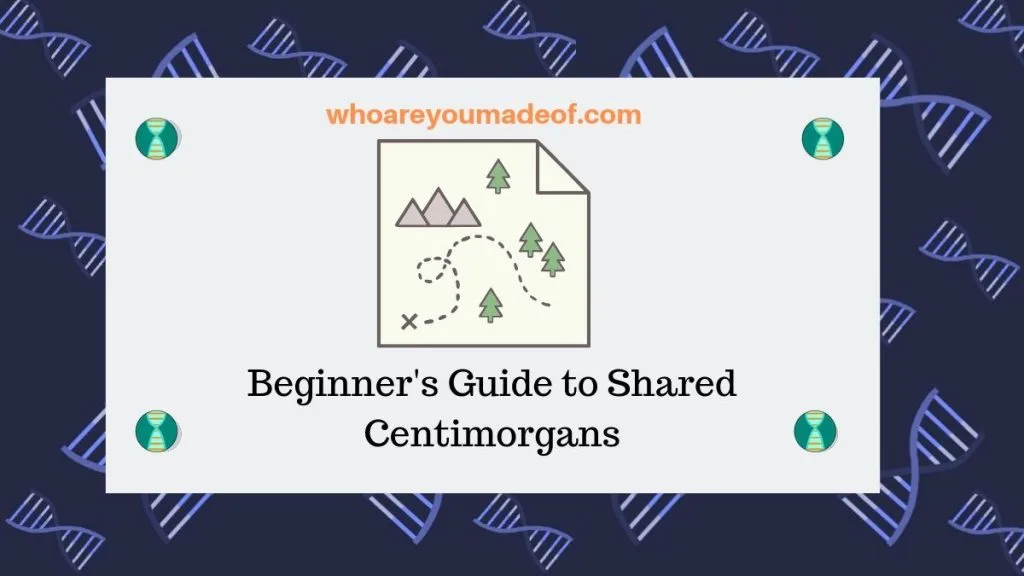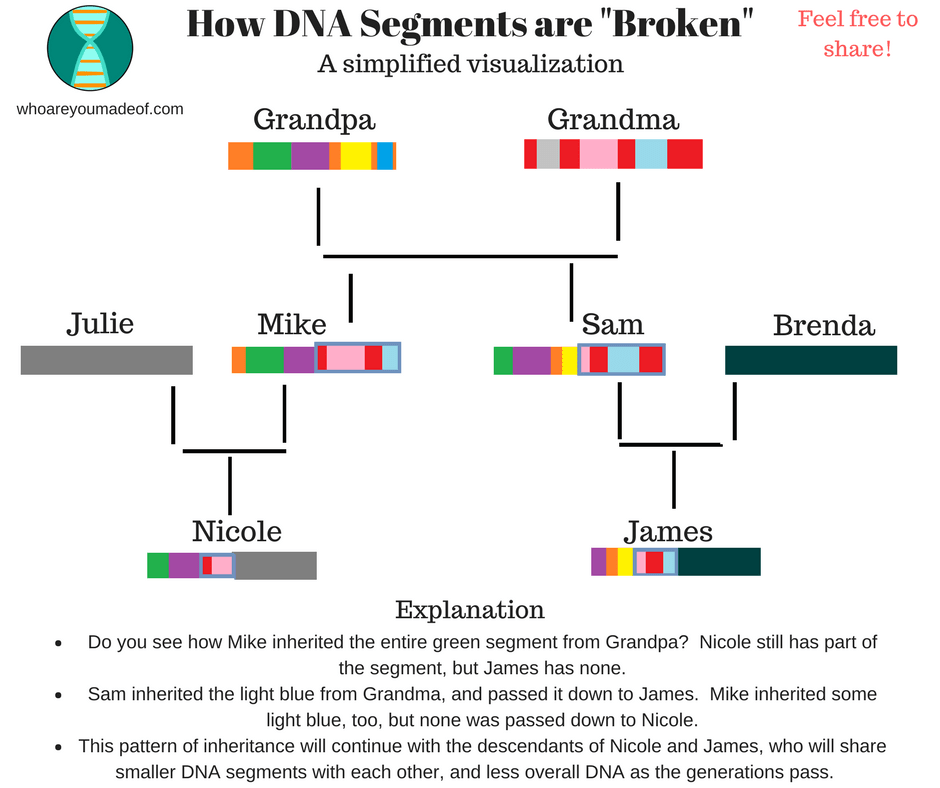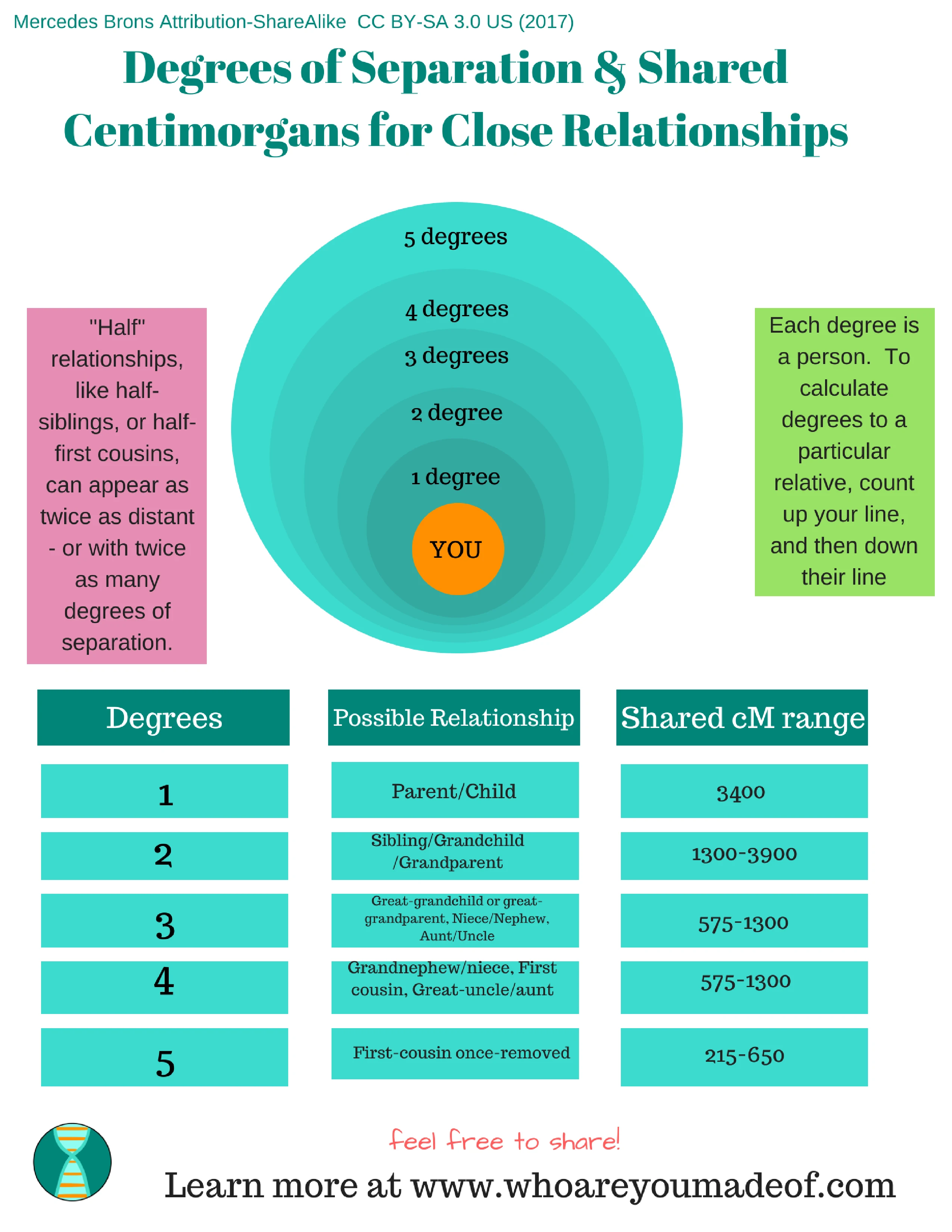In this beginner’s guide to shared centimorgans, learn all about DNA segments and how to estimate your relationship with your DNA match using shared centimorgans. I’ll answer questions like “what is a centimorgan?”, and more!

In this article, find out:
- How many centimorgans a person has
- What is a DNA segment, and what is represents
- How DNA segments get smaller
- How to use shared centimorgans to figure out how you are related to your DNA match
- How many centimorgans you should share with your known biological relatives
Your DNA matches provide an excellent source of information, and the DNA shared between you provides that clues needed to determine your relationship.
DNA matches are the crown jewel of DNA testing, since your DNA matches can help you prove your pedigree and build a better, more accurate family tree. This beginner’s guide to shared centimorgans will give you all of the basic information that you need to learn the most from your DNA matches.
I’ll use the word “centimorgan” in this article, but you should know that sometimes the word is abbreviated: “cM” or “cMs”.
What is a centimorgan?
A centimorgan (cM) is just a fancy word that that geneticists use to describe the length of DNA segments – specifically, the difference between chromosome positions. The meaning of cM in DNA describes how much DNA is shared between two people.
We inherit DNA on each chromosome from each parent, and we will share segments of genetic material, otherwise known as DNA segments, of varying sizes with our relatives. The unit of measurement used to describe the size of these segments is a “centimorgan”.
It’s very easy to confuse the word centimorgans and centimeters, but it is important to know that the word centimorgan doesn’t describe a physical distance. Instead, centimorgan measures genetic distance, which is something very different.
How many centimorgans does a person have?
Every person has approximately 6800 centimorgans of DNA. This number includes both copies of each numbered chromosome, or approximately 3400 centimorgans inherited from each parent.
Some sources estimate the number of centimorgans that has a person has at 7200 cMs, or even a very specific number like 7074.60. The reason that there is slight variation in the estimate of total number of centimorgans in one person is that each DNA testing company examines slightly different numbers of locations in the genome.
How can understanding how many centimorgans a person have help with DNA matches?
We know that a person has approximately between 6800 centimorgans (cMs) of DNA. Knowing this number helps us better understand the amount of DNA that we share with our relatives.
For example, if we have 6,800 centimorgans and we inherited 50% of our DNA from each of our parents, it means that we inherited about 3,400 cMs from each parent.
The number of total centimorgans that a person has can also help you easily use the number of centimorgans shared with someone to calculate the total percentage of DNA shared.
To calculate the percentage of DNA shared, simply divide the total number of centimorgans shared by 6800. For example, if you share 217 centimorgans with a match, just do this calculation:
- 217/6800 = 3.19% shared DNA
What is a DNA segment?
The distance between the location on the chromosome where the shared DNA starts to the point where it ends is measured in centimorgans. The total genetic distance is called a DNA segment.
Each DNA segment, measured in centimorgans, will have a specific length. The length of a DNA segment can provide clues about how distant the common ancestor is between two DNA matches.
What does each DNA segment represent?
Most DNA segments that you share with your DNA match represent a common ancestor, or multiple common ancestors. You can inherit multiple DNA segments from the same recent ancestor, or only one small segment from a very distant one.
People who are very closely related will share many DNA segments with each other, ranging from small to large. People who are distantly related to each other might only have one tiny segment in common.
You can be related to someone distantly on both sides of your family, and share two or more tiny DNA segments inherited from shared maternal and paternal ancestors.
Generally speaking, you can’t tell exactly how you are related based on the number of shared DNA segments, but it does provide some clues. The most important aspect of shared centimorgans is the length, or the size, of share DNA segments and the total amount of DNA shared.
Why is the size of a DNA segment important?
Size definitely matters when it comes to DNA segments. The longer the DNA segment you share with your DNA match, the closer relationship. The opposite is true for distant relationships – the smaller the segment, the more distant the relationship.
These statements are true in a general sense, but it’s always possible to share more DNA with a relative who is more distantly related to you than a more closely related relative. This is something important to keep in mind when you go through your matches.
How do DNA segments get smaller?
The reason that you share smaller DNA segments with your distant relatives than you do with your closest family is because of the way that DNA is inherited.
Each person inherits 50% of their DNA from each parent, and over time, the descendants of the original couple will share less and less DNA with each other (on the different lines of the family).
The 50% each offspring will inherit from that original couple will be slightly different, and the same is true for their children, their grandchildren, and so on.
Longer DNA segments are often broken up when passed down. For this reason, taking a look at the number of shared centimorgans and DNA segments can reveal additional information to us.
For example, a man might share a 65 centimorgan segment with his grandfather, but his son (the great-grandson) maybe have only inherited 30 centimorgans (cMs) of that original segment.
I have created a visual to help you understand how segments are broken up in a family line:

How do I use shared centimorgans to determine a relationship?
There is a range of shared DNA that is typical for each relationship type, but there is no exact amount of DNA that you will share with any particular relative.
In order to use shared centimorgans (or total shared DNA) to figure out how you are related to your DNA match, you will have to take into consideration the total amount of shared DNA, the size of the longest segment, and known information about your DNA relative (i.e. their posted family tree or what they have told you about themselves).
In other words, information obtained from total number of shared centimorgans and DNA segments can help you determine how far back you would need to look in your family tree to find the ancestors shared with your match.
With a little bit of detective work, some common sense, and a little bit of deductive reasoning (or inductive?) you just might be able to figure out exactly who your mystery match is to you.
The takeaway from all of this?
- A centimorgan is a unit of measurement to describe the length of a shared DNA segment
- A DNA segment is shared genetic material between two individuals, reported in centimorgans (cMs)
- If you know the total amount of DNA that you share with someone, and the length of the segments, you might be able to narrow down relationship possibilities.
How many centimorgans should you share with your relatives?
As you have learned, we share more DNA segments (measured in centimorgans) with people who are more closely related to us. The opposite is also true, meaning that we share fewer DNA segments with people who are more distantly related.
It is also possible to be distantly related to someone and share no DNA segments. This means that we can be related to our distant relatives, yet share zero centimorgans.
There are ranges of shared DNA that we generally expect to see for most relationship types.
Parents and children share the most centimorgans
The only relationship that has a fairly definite amount of DNA shared is that between a parent and child. Since a child inherits 50% of their DNA from a parent, then shared centimorgans for a relationship of this sort will be very close to the “total” number of centimorgans that a human has in their DNA.
The total amount of centimorgans is approximately 6800. The exact number used will vary insignificantly from company to company, but we will use 6800 for the purpose of our post.
If the total number of centimorgans that a person can have is 6800, and they inherited half from each parent, then they should share about 3400 cMs with each parent.
The exact number that shows up for a parent/child relationship could vary very slightly, but it should not vary much. If you have a match that shares 3400 cMs, then it is either a parent, child, or identical twin to you.
Degrees of separation determine how much shared DNA between relatives
For other close relationships, the shared centimorgan ranges get a little more complicated. The following chart is an overview of the shared centimorgans between other close family relationships:
For a more detailed DNA centimorgan chart, be sure to read the following post that includes a chart as well as instructions for how to use it:
Do you share DNA with all of your relatives?
We share DNA with all of our close relatives and many of our more distant relatives. You will absolutely, positively share DNA with people of the following relationships:
(you can click on each relationship to see a more detailed article about shared DNA for that relationship distance)
- Parent/Child
- Siblings, half-siblings
- Aunts/Uncles
- Grandparents, Great-aunts/Great-uncles
- Grandchildren, Great-nieces/Great-nephews
- First cousins
- Second cousins (share an average of 212 cMs)
- Any relationship not listed that is a second-cousin or closer in degrees of separation
For relationships more distant than second cousin, using shared centimorgans to estimate your relationship gets a little dicier. The following are the probabilities that you will share DNA with any given cousin at more distant relationships:
- 90% of your third cousins will share DNA with you
- 50% of your fourth cousins will share DNA with you
- 15%-32% of your fifth cousins will share DNA with you (depending on which company you test with)
- 4-11% of your sixth cousins will share DNA with you (again depending on which company you test with)
- 1-3% of your seventh cousins will share DNA with you
- Less than 1% of your eighth cousins will share DNA with you
How many shared centimorgans will I share with distant cousins?
Because there is a possibility that a relative more distant than second cousin shares no DNA with you, the bottom end of the range of shared DNA in centimorgans will always be zero.
The top end of the range will always vary, but generally speaking, the following is a good representation of the average shared centimorgans for various cousin relationships, based on my own research of verified cousin relationships:
- Third cousins (0- 215 cMs, average 47 cMs)
- Fourth cousins (0- 27 cMs, average 21 cMs)
- Fifth cousins (0 – 25 cMs, average 17 cMs)
- Sixth cousins (0 – 21 cMs, average 15 cMs)
- Seventh cousins (0 – 17 cMs, average 13 cMs)
- Eighth cousins (0 – 12 cMs, average 13 cMs)
All of the shared cM ranges displayed are averages, and it’s always possible for a relationship to fall slightly out of the range.
If the number of shared centimorgans with a particular relative doesn’t seem to match up, you should take some time to examine the shared DNA more closely to see if there is something going on that you might have missed.
Are you trying to determine how a DNA match might fit into your family tree?
Now that you understand how the total number of shared centimorgans can be used to help you determine where a DNA match might fit into your tree, it’s important to note that having a more complete (and a wider) family tree will help you identify your match’s relationship to you more easily.
If you haven’t yet started building a family tree, or if it really hasn’t been a focus of your learning and research, I completely understand. Family trees (i.e. genealogy) wasn’t really my focus when I first got into DNA testing.
Over the years, I have learned how much time having a good tree can save me. I’m able to spot my relationship to my DNA matches, or at least our probable relationship, fairly quickly.
I build my family trees on Ancestry for several reasons, but primarily because of the simplicity of having my DNA results and tree on the same site. Plus, it’s free and easy to do (I like free!).
It’s always free to have a family tree, no subscription needed!
To learn the basics of family tree research, especially for beginners, definitely read my book Family Tree Building Basics: A Book for Beginners, available in softcover on Amazon or via immediate PDF download.
Learn More
Don’t forget to visit my DNA Tools Page to learn more about the resources available (like other helpful blog posts) available on this site, as well as tools on other websites that can help you learn as much about your DNA results as possible.
Conclusion
I hope that this post helped you understand shared centimorgans a little better, and that you are able to use this information to make sense of your DNA match list.
If you have any questions about something that you have read, or would just like to share your experience, please feel free to leave a comment below. I look forward to hearing from you.
Thanks for stopping by!



Gwendoline
Sunday 30th of July 2023
So many of my DNA matches I am trying to connect to, have from two to four seg. on the same chr. Individual seg. may as low as 3or 5 cM, but with 4 seg on the same chr eg, chr 18, 4 seg, 3.6cM, 4cm. 6cm and 3.4cM =17Cm. What significants does this have, if any? Regards Gwen
lisa
Tuesday 6th of June 2023
Hi, If I share 787 cM's in 23 SNP chains, largest being 1401 snp's - so approx 8% shared DNA... but the ancestor is from 1095AD... I'm thinking this makes him a direct ancestor? Mind blowing!
Dreena Dixon
Saturday 27th of August 2022
This was very informative. What I do not understand is how the number of cM varies from one cousin to the next when the cousins are siblings. These are my second cousins. It seems like my older cousin (same mother and father) has less cMs than her sister in relationship to me. Why is that? Shouldn't both have the same amount of cMs? I would be interested in your thoughts on the matter.
LiAnn Carter
Monday 14th of February 2022
We are looking for my 3rd great grandfather who is either George L Conner or his brother Jeptha Conner. If I have 4 people who share 40 cM on Jeptha's line, and numerous people at 12 cm (average) on George"s line, who is the likely brother that I am directly related to?
Frank Steele
Monday 3rd of January 2022
Great information. Thank you for explaining g things so that it can be easily understood.